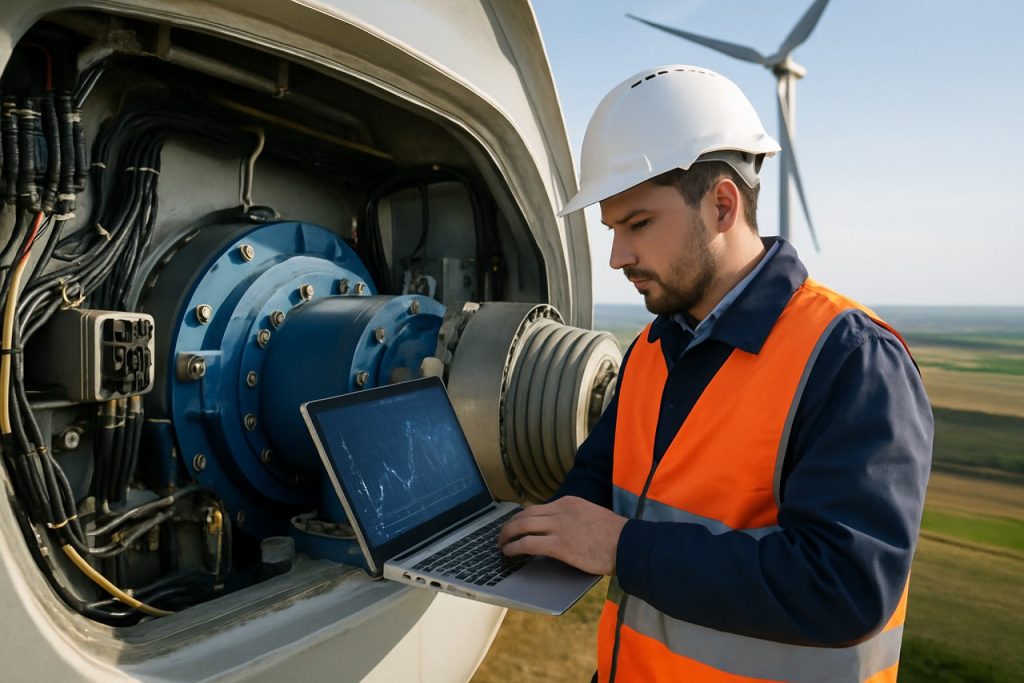
Wind Turbine Drivetrain Diagnostics Market Report 2025: In-Depth Analysis of Technology, Growth Drivers, and Global Trends. Discover How Advanced Analytics and Condition Monitoring Are Shaping the Future of Wind Energy Reliability.
- Executive Summary & Market Overview
- Key Technology Trends in Drivetrain Diagnostics
- Competitive Landscape and Leading Players
- Market Growth Forecasts (2025–2030): CAGR, Revenue, and Volume Analysis
- Regional Analysis: North America, Europe, Asia-Pacific, and Rest of World
- Future Outlook: Innovations and Emerging Business Models
- Challenges and Opportunities in Wind Turbine Drivetrain Diagnostics
- Sources & References
Executive Summary & Market Overview
The wind turbine drivetrain diagnostics market is poised for significant growth in 2025, driven by the global expansion of wind energy capacity and the increasing emphasis on operational efficiency and predictive maintenance. Drivetrain diagnostics encompass the monitoring, analysis, and early detection of faults in critical components such as gearboxes, generators, and main shafts, which are essential for minimizing downtime and optimizing the lifecycle of wind turbines.
As of 2025, the global wind energy sector continues its robust expansion, with cumulative installed capacity projected to surpass 1,000 GW, according to the Global Wind Energy Council. This surge in installations, particularly in offshore and remote locations, has heightened the need for advanced diagnostic solutions that can ensure reliability and reduce costly unplanned maintenance. The drivetrain, being one of the most failure-prone and expensive subsystems, is a focal point for asset owners and operators seeking to maximize return on investment.
Market analysis indicates that the adoption of condition monitoring systems (CMS) and predictive analytics platforms is accelerating. These technologies leverage vibration analysis, oil debris monitoring, and machine learning algorithms to provide real-time insights into drivetrain health. Leading OEMs and service providers, such as GE Renewable Energy and Siemens Gamesa Renewable Energy, are integrating advanced diagnostics into their digital service offerings, enabling remote monitoring and proactive maintenance scheduling.
The market is also witnessing increased collaboration between technology vendors and wind farm operators to develop tailored diagnostic solutions. For example, partnerships with data analytics firms and sensor manufacturers are resulting in more accurate fault detection and root cause analysis, reducing the risk of catastrophic failures. According to a recent report by Wood Mackenzie, the global market for wind turbine condition monitoring systems is expected to grow at a CAGR of over 7% through 2025, with drivetrain diagnostics representing a substantial share of this growth.
In summary, the wind turbine drivetrain diagnostics market in 2025 is characterized by technological innovation, increased digitalization, and a strong focus on predictive maintenance. These trends are set to enhance asset reliability, lower operational costs, and support the continued expansion of wind energy worldwide.
Key Technology Trends in Drivetrain Diagnostics
In 2025, wind turbine drivetrain diagnostics are being transformed by several key technology trends, driven by the need to maximize asset uptime, reduce maintenance costs, and extend turbine lifespans. The integration of advanced sensor technologies, artificial intelligence (AI), and cloud-based analytics is at the forefront of this evolution.
One of the most significant trends is the deployment of high-fidelity, multi-parameter sensors that monitor vibration, temperature, oil quality, and acoustic emissions in real time. These sensors provide granular data on critical drivetrain components such as gearboxes, bearings, and generators, enabling early detection of anomalies and potential failures. The adoption of wireless sensor networks is also increasing, allowing for easier retrofitting and reduced installation costs, especially in offshore wind farms where accessibility is a challenge (GE Renewable Energy).
AI and machine learning algorithms are being increasingly utilized to process the vast amounts of data generated by these sensors. Predictive maintenance models, trained on historical and real-time data, can now identify subtle patterns and predict failures with greater accuracy than traditional rule-based systems. This shift is reducing unplanned downtime and optimizing maintenance schedules, leading to significant cost savings for operators (Siemens Gamesa).
Cloud-based diagnostic platforms are another major trend, enabling centralized data aggregation and analysis across entire wind fleets. These platforms facilitate remote monitoring, collaborative troubleshooting, and benchmarking of turbine performance across different sites and manufacturers. The scalability and accessibility of cloud solutions are particularly valuable for operators managing geographically dispersed assets (Vestas).
Additionally, the integration of digital twin technology is gaining momentum. Digital twins—virtual replicas of physical drivetrain systems—allow operators to simulate various operating conditions, assess the impact of component wear, and optimize maintenance strategies without physical intervention. This approach enhances decision-making and supports the transition to condition-based maintenance (DNV).
Collectively, these technology trends are enabling a shift from reactive to proactive and predictive drivetrain diagnostics in the wind energy sector, supporting higher reliability, lower operational costs, and improved return on investment for wind farm operators in 2025.
Competitive Landscape and Leading Players
The competitive landscape of the wind turbine drivetrain diagnostics market in 2025 is characterized by a mix of established industrial conglomerates, specialized technology providers, and emerging startups. The sector is driven by the increasing deployment of wind energy assets globally, the rising need for predictive maintenance, and the integration of advanced analytics and IoT technologies into wind farm operations.
Key players in this market include GE Renewable Energy, Siemens Gamesa Renewable Energy, and Vestas Wind Systems, all of which have developed proprietary drivetrain monitoring and diagnostic solutions as part of their broader wind turbine service portfolios. These companies leverage their extensive installed base and global service networks to offer integrated condition monitoring systems (CMS) that utilize vibration analysis, oil debris monitoring, and advanced data analytics to detect early signs of drivetrain faults.
Specialized technology firms such as Brüel & Kjær Vibro and SKF Group are also prominent, providing dedicated CMS hardware and software platforms tailored for wind turbine applications. Their solutions are often turbine-agnostic, enabling deployment across multiple OEMs and facilitating independent service providers’ entry into the diagnostics market. These companies are increasingly focusing on cloud-based analytics and machine learning algorithms to enhance fault detection accuracy and reduce false positives.
Emerging players and startups, such as ONYX Insight and Sentient Science, are gaining traction by offering advanced predictive analytics, digital twin modeling, and remote diagnostics services. Their platforms often integrate data from multiple sources—including SCADA, CMS, and weather data—to provide holistic drivetrain health assessments and actionable maintenance recommendations.
- Market consolidation is evident, with larger OEMs acquiring or partnering with analytics firms to strengthen their digital service offerings.
- There is a growing trend toward open, interoperable diagnostic platforms, driven by asset owners’ desire for flexibility and multi-brand fleet management.
- Regional competition is intensifying, particularly in Asia-Pacific, where local players are developing cost-effective solutions tailored to rapidly expanding wind markets.
Overall, the 2025 market is marked by technological innovation, strategic partnerships, and a shift toward data-driven, service-oriented business models, as players vie to capture value in the growing wind turbine drivetrain diagnostics segment.
Market Growth Forecasts (2025–2030): CAGR, Revenue, and Volume Analysis
The wind turbine drivetrain diagnostics market is poised for robust growth between 2025 and 2030, driven by the increasing deployment of wind energy assets and the rising emphasis on predictive maintenance to minimize downtime and operational costs. According to projections by MarketsandMarkets, the global wind turbine condition monitoring market—which includes drivetrain diagnostics—is expected to register a compound annual growth rate (CAGR) of approximately 7.5% during this period. This growth is underpinned by the expanding installed base of wind turbines, particularly in offshore wind farms, where drivetrain reliability is critical due to high maintenance costs and challenging access conditions.
Revenue from drivetrain diagnostics solutions is anticipated to rise in tandem with the overall condition monitoring market. By 2030, the segment is projected to contribute significantly to the market’s total value, with estimates suggesting that drivetrain diagnostics could account for over $500 million in annual revenues globally, up from approximately $320 million in 2025. This surge is attributed to the adoption of advanced sensor technologies, machine learning algorithms, and cloud-based analytics platforms that enable real-time monitoring and early fault detection in critical drivetrain components such as gearboxes, bearings, and generators.
In terms of volume, the number of wind turbines equipped with drivetrain diagnostic systems is expected to grow substantially. Data from Wood Mackenzie indicates that by 2030, over 60% of new wind turbine installations will feature integrated drivetrain diagnostics, compared to less than 40% in 2025. Retrofitting of existing turbines, especially in mature markets like Europe and North America, will further boost the installed base of diagnostic systems.
- CAGR (2025–2030): ~7.5%
- Revenue (2025): ~$320 million
- Revenue (2030): >$500 million
- Volume Penetration (2030): >60% of new installations
Key market drivers include stricter regulatory requirements for turbine reliability, the financial imperative to reduce unplanned maintenance, and the growing sophistication of digital monitoring solutions. As the wind energy sector continues to scale, drivetrain diagnostics will play an increasingly central role in asset management strategies, supporting both operational efficiency and long-term sustainability.
Regional Analysis: North America, Europe, Asia-Pacific, and Rest of World
The wind turbine drivetrain diagnostics market exhibits distinct regional dynamics across North America, Europe, Asia-Pacific, and the Rest of the World, shaped by varying levels of wind energy adoption, regulatory frameworks, and technological maturity.
North America remains a significant market, driven by the United States’ extensive wind power capacity and Canada’s growing investments. The region’s focus on reducing operational costs and maximizing turbine uptime has accelerated the adoption of advanced drivetrain diagnostics, including condition monitoring systems and predictive analytics. The presence of major OEMs and service providers, such as GE Renewable Energy, further supports innovation and deployment. The U.S. Department of Energy’s continued funding for wind technology R&D is expected to bolster market growth through 2025.
Europe leads in both installed wind capacity and the sophistication of drivetrain diagnostics. Countries like Germany, Denmark, and the UK have mature wind sectors, with stringent regulations on turbine reliability and safety. The European Union’s Green Deal and ambitious renewable targets are pushing asset owners to invest in advanced diagnostics to extend turbine lifespans and reduce maintenance costs. Companies such as Siemens Gamesa and Vestas are at the forefront, integrating AI-driven analytics and remote monitoring solutions. Offshore wind, particularly in the North Sea, is a key driver for high-value diagnostic technologies due to the complexity and cost of maintenance in marine environments.
- Asia-Pacific is experiencing the fastest growth, led by China’s dominance in new wind installations and India’s expanding market. The region’s focus is shifting from rapid capacity addition to operational excellence, spurring demand for drivetrain diagnostics to address reliability issues in large, geographically dispersed fleets. Local players and global OEMs are investing in scalable, cost-effective solutions tailored to the region’s diverse climatic and grid conditions. Government incentives and grid modernization efforts in China and India are expected to further stimulate adoption through 2025 (International Energy Agency).
- Rest of World includes emerging markets in Latin America, the Middle East, and Africa. While wind capacity is lower, countries like Brazil and South Africa are investing in diagnostics to support new projects and attract international financing. The adoption rate is slower, but as wind penetration increases, so will the need for advanced drivetrain monitoring and predictive maintenance solutions (Global Wind Energy Council).
Overall, regional trends in drivetrain diagnostics reflect the maturity of wind markets, regulatory pressures, and the drive for cost-effective, reliable renewable energy generation.
Future Outlook: Innovations and Emerging Business Models
The future outlook for wind turbine drivetrain diagnostics in 2025 is shaped by rapid technological innovation and the emergence of new business models aimed at maximizing turbine uptime and reducing operational costs. As the global wind energy sector expands, operators are increasingly prioritizing predictive maintenance and real-time monitoring to address the high costs associated with drivetrain failures, which remain one of the most significant sources of unplanned downtime in wind farms.
Key innovations are centered around the integration of advanced sensor technologies, artificial intelligence (AI), and machine learning (ML) algorithms. These technologies enable more accurate detection of early-stage faults in critical drivetrain components such as gearboxes, bearings, and generators. For instance, the deployment of edge computing devices allows for on-site data processing, reducing latency and enabling immediate response to emerging issues. Companies like GE Renewable Energy and Siemens Gamesa Renewable Energy are investing heavily in digital platforms that combine SCADA data, vibration analysis, and thermal imaging to deliver comprehensive diagnostics and prognostics.
Emerging business models are also transforming the landscape. The shift from traditional time-based maintenance to condition-based and predictive maintenance is being accelerated by service providers offering diagnostics-as-a-service (DaaS). This model allows wind farm operators to outsource drivetrain monitoring and analytics to specialized firms, reducing the need for in-house expertise and capital investment in diagnostic infrastructure. Companies such as SKF and Baker Hughes are expanding their service portfolios to include remote monitoring, data analytics, and even performance-based contracts, where compensation is tied to turbine availability and reliability.
Looking ahead to 2025, the adoption of digital twins—virtual replicas of physical drivetrain systems—is expected to become mainstream. Digital twins enable continuous simulation and health assessment, allowing operators to predict failures with greater accuracy and optimize maintenance schedules. Furthermore, the integration of cloud-based platforms facilitates fleet-wide analytics, enabling benchmarking and best-practice sharing across geographically dispersed assets.
Overall, the convergence of advanced diagnostics, AI-driven analytics, and innovative service models is poised to significantly enhance the reliability and cost-effectiveness of wind turbine drivetrain operations, supporting the continued growth and competitiveness of the wind energy sector worldwide Wood Mackenzie.
Challenges and Opportunities in Wind Turbine Drivetrain Diagnostics
The wind turbine drivetrain, comprising components such as the gearbox, generator, and main shaft, is critical to the overall reliability and efficiency of wind energy systems. As the global wind energy market matures and installed capacity increases, the need for advanced drivetrain diagnostics becomes more pronounced. In 2025, the sector faces a complex landscape of challenges and opportunities shaped by technological, operational, and economic factors.
One of the primary challenges in drivetrain diagnostics is the early detection of faults in harsh and variable operating environments. Drivetrain components are subject to fluctuating loads, temperature extremes, and contamination, which can accelerate wear and complicate condition monitoring. Traditional vibration analysis and oil debris monitoring, while valuable, often struggle to distinguish between benign anomalies and critical failures, leading to false alarms or missed detections. The integration of advanced sensor technologies and high-frequency data acquisition systems is essential, but these solutions can be costly and require robust data management infrastructure (DNV).
Another significant challenge is the scalability of diagnostic solutions across large, geographically dispersed wind farms. As wind projects grow in size, centralized monitoring and remote diagnostics become necessary, demanding secure and reliable data transmission. Cybersecurity concerns and interoperability between different turbine models and monitoring platforms further complicate deployment (Wood Mackenzie).
Despite these hurdles, the market presents substantial opportunities. The adoption of artificial intelligence (AI) and machine learning (ML) algorithms is transforming drivetrain diagnostics by enabling predictive maintenance and reducing unplanned downtime. These technologies can analyze vast datasets from multiple turbines, identify subtle patterns indicative of emerging faults, and optimize maintenance schedules. According to MarketsandMarkets, the global predictive maintenance market in wind energy is expected to grow significantly through 2025, driven by cost savings and improved asset availability.
Furthermore, the increasing digitalization of wind assets and the proliferation of Industrial Internet of Things (IIoT) devices are creating new business models for service providers. OEMs and independent service providers are leveraging cloud-based platforms to offer diagnostics-as-a-service, enabling operators to access expert insights without large upfront investments (GE Renewable Energy).
In summary, while drivetrain diagnostics in wind turbines faces technical and operational challenges in 2025, advancements in AI, IIoT, and digital platforms are unlocking new opportunities for reliability, efficiency, and value creation in the wind energy sector.
Sources & References
- Global Wind Energy Council
- GE Renewable Energy
- Siemens Gamesa Renewable Energy
- Wood Mackenzie
- Vestas
- DNV
- Brüel & Kjær Vibro
- SKF Group
- ONYX Insight
- Sentient Science
- MarketsandMarkets
- International Energy Agency
- Global Wind Energy Council
- Baker Hughes



